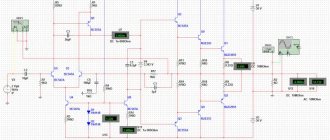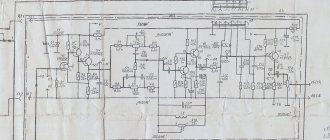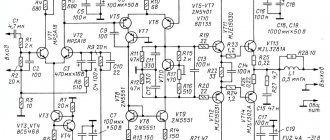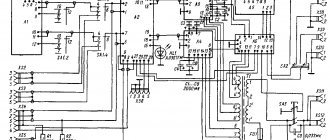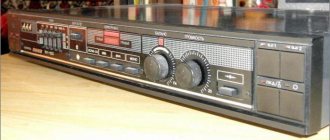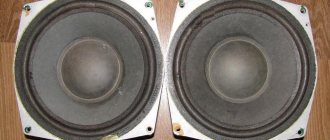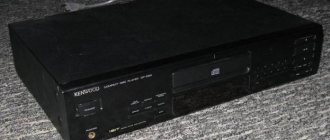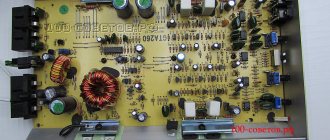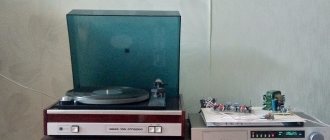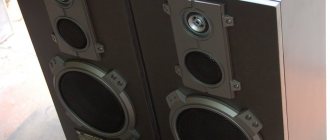The first article in the series about resurrections and reincarnations was about “Radio Engineering U-101”: Audio Amplifier Radio Engineering U-101. Back to life. Today we will deal with her brother “Amphiton”. Long ago, in the 80s, when I was a student, I often went to the Central Department Store in the “Radio Products” department to admire the new equipment. The prices for a student were too high, so I couldn’t afford it then, but times have changed, I’ve grown up, the equipment of that time has aged, become cheaper, and now you can get to know it better.
Recently, the Amphiton U-101-1 amplifier was purchased at a reasonable price. Appearance is a solid “4”.
There is an assumption that the appearance of the amplifier was ripped off from Aurex, but I won’t say for sure.
Actually, it was purchased as a donor, for its huge body and shiny aluminum handles on the front panel. I like his appearance. I wanted to stick the datagor kit “QUAD-405” from Kostya Gutman there, but first I decided to listen to the voice of “Amphiton”.
↑ 1. Power supply
The transformer is of good quality, quite tolerable for the stated 2 x 20W. The performance characteristics (tactical and technical characteristics) in the passport indicate that the power consumption is 125 W. Wound as “dual mono”, i.e. Each amplifier has its own secondary winding. This seems to be a plus. But I was haunted by weak diode bridges and resistors R37 = 1 Ohm at the midpoint. And there were no power fuses in this modification. Apparently, the calculation was for the combustion of that same R37. To confirm my statements, I give photos of homemade resistors. We will remove them.
Due to the availability of free space, it was decided to assemble a separate power supply with other diodes, filter capacitors and fuses in each arm. The rectifier is assembled according to the classical scheme.
This is how we assemble “dual mono”.
We must pay tribute, the original capacitors of the K-50-4 filter turned out to be quite functional and passed the “approval” of my ESR meter, so they were left in their places. The result was 2 pieces for each channel. 4700 + 2200 uF each. Since the power is small, we make all connections with 0.75 mm2 wire. We set the fuses to 3.15 A. Now the power supply is in perfect order!
Where can I buy?
Currently, it is not possible to find the original Amphiton-002 in retail sales. That is, it is impossible to buy a new device. It can only be found on the secondary market. At all sorts of flea markets you can easily buy such an amplifier in good condition. Sometimes you can even come across modified models that boast better sound quality. The price of such an “Amphiton” can vary from 1,000 to 2,000 rubles. It is not expensive. Especially when you consider the class of the device.
↑ 2. Final amplifiers
An ordinary renovation, nothing special to brag about. Replacing fried emitter resistors R32 and R33, replacing failed transistors, selecting them in pairs, replacing tuning resistors with multi-turn ones, replacing “clay” capacitors with tubular and film ones, replacing ALL electrolytic capacitors, replacing the OOS capacitor C5 = 50 μF with a non-polar one, which one was on hand = 220 uF.
We short-circuit the input. Set “0” at the output of the terminal. Then we output the quiescent current of the output transistors. In this amplifier I set it to 50 mA. As a habit developed over the years, I use car lamps connected to the break in the power wires. It's calmer this way. In this case, 24 V 21 W lamps were used, connected in series (in each power arm).
And, of course, replacing the output connectors.
I figured that one pair of outputs would be enough for me, so one relay for protection and one pair of old sockets had to be removed.
One of the advantages of this operation is that there are fewer switching wires on the outputs, and the button for switching “Main and additional speakers” has turned into MUTE. Yes, I also replaced the wheezing volume control with a new one (luckily I found it in my bins).
The most interesting videos on Youtube
Old Soviet speaker systems can hardly compete with modern advanced Hi-End devices, but they can be used as a budget solution, especially if you already have them.
Well, if you still have similar high-class devices, then they can still compete with some Chinese crafts.
The only problem that arises when using these “dinosaurs” is connecting to a computer.
To connect, you will need a cable with a 3.5 mm jack or the same adapter and a low-frequency cable with a five-pin audio connector. https://oldoctober.com/ru/
Old amplifiers did not come with long cables for connecting the audio signal, and it is likely that you will have to make it yourself. You can read about how to solder a shielded cable to the plugs here. >>>
To make a cable, you will need the cable itself and two connectors - a jack and a five-pin audio connector. The cable itself must be shielded, and the wires connecting the left and right channels must each have their own shielding braid.
This is what the plugs we need look like:
Cable termination:
Audio connector pinout:
Scheme for connecting the plugs to each other:
Modern budget connectors sold on radio markets require the use of active flux when unsoldering. This is due to their nickel plating.
Such solderings should be washed with at least water so that residual active flux does not cause failure over time. (Rosin-based flux does not require rinsing.)
Now about connecting the amplifier to the computer itself. It is important!
It is best to connect the amplifier when both the computer and the amplifier are completely de-energized.
This is due to the fact that switching power supplies, which are used in computers, do not provide complete AC isolation between the case and the network. As a result, an alternating current voltage of up to 110 Volts may be present on the case of the system unit of an ungrounded computer. And although this current does not exceed 1 mA, it can damage a pre-amplifier that has a high input resistance.
Since when connecting a Jack plug, the left and right channels are first connected to the housing, this voltage can be applied to the high-impedance input of the connected amplifier. Which can lead to its failure.
The only condition for completely safe connection of an amplifier with a computer “on the go” is a reliable electrical connection between the computer case and the amplifier case BEFORE connecting the audio connector.
However, it is better to turn off everything.
Summary table of some Soviet power amplifiers:
| Model | Class | Power (Watt) | Frequency range (Hertz) | R load (Ohm) |
| Amphiton-002 | 0 | 2 X 25 | 20…25000 | 4 |
| Amfiton-35U-101S | 1 | 2 X 65 | 20…20000 | 4 |
| Amfiton-50-UM104S | 1 | 2 X 50 | 20…25000 | 4 |
| Amphiton-A1-01-2 | 1 | 2 X 20 | 20…20000 | 4 |
| Amphiton-A1-01-U | 0 | 2 X 50 | 20…30000 | 4 |
| Amfiton-U-002M | 0 | 2 X 35 | 20…25000 | 4 |
| Amphiton-UM-003 | 0 | 2 X 50/90 | 20…25000 | 8 |
| Arcturus-001 | 0 | 2 X 40 | 20…20000 | 4 |
| Arcturus-002 | 0 | 2 X 25 | 30…20000 | 4 |
| Arcturus-101 | 1 | 2 X 15 | 20…18000 | 4 |
| Bark-001 | 0 | 2 X 50/? | 20…25000 | 8/4 |
| Brig-001 | 0 | 2 X 50/? | 20…25000 | 8/4 |
| Helios-001 | 0 | 2 X 100 | 20…20000 | 4 |
| Corvette-200UM-088S | 0 | 2 X 180 | 20…20000 | 4 |
| Corvette-50U-068S | 0 | 2 X 60/80 | 10…70000 | 8/4 |
| Corvette-UM-048 | 0 | 2 X 100 | 20…25000 | 4 |
| Corvette-UM-068 | 0 | 2 X 60/80 | 10…70000 | 8/4 |
| Idol-101 | 1 | 2 X 35 | 20…25000 | 4 |
| Laspi-005 | 0 | 2 X 25 | 20…20000 | 8 |
| Laspi-005-1 | 0 | 2 X 40 | 20…25000 | 4 |
| Lorta-75U101 | 1 | 2 X 40 | 20…25000 | 4 |
| Nota-35U120 | 1 | 2 X 50 | 20…20000 | 4 |
| Odysseus-001 | 0 | 2 X 30 | 20…30000 | 4 |
| Odyssey-002 | 0 | 2 X 20 | 20…20000 | 4 |
| Orbita-UM002 | 0 | 2 X 50 | 20…25000 | 4 |
| Radio engineering-020 | 0 | 2 X 70 | 20…30000 | 4 |
| Radiotekhnika-U-120 | 1 | 2 X 15 | 20…20000 | 4 |
| Radiotekhnika-U-7111 | 0 | 2 X 50/100 | 10…30000 | 8/4 |
| Radiotekhnika-UM-7011 | 0 | 2 X 200 | 4…16000 | ? |
| Rostov-Don-101 | 1 | 4 X 16 | 63…18000 | 4 |
| Trembita-002 | 0 | 2 X 60 | 20…20000 | 4 |
| Phoenix-50U-008S | 0 | 2 X 50 | 20…25000 | 4 |
| Forum-180U-001 | 0 | 2 X 90 | 20…20000 | 4 |
| Forum-U-001 | 2 X 100 | 20…25000 | 4 | |
| Edektronika-T1-040 | 0 | 2 X 25 | 20…20000 | 4 |
| Edektronika-U-104 three-way | 1 | HF 2 X 25 | 5000…20000 | 8 |
| SCH 2 X 35 | 500…5000 | 4 | ||
| LF 2 X 35 | 20…500 | 4 | ||
| Edektronika-UK-043 | 0 | 2 X 20 | 20…20000 | 8 |
| Edektronika-UK-045 | 0 | 2 X 25 | 20…25000 | 8 |
| Electron-103 | 1 | 2 X 15 | 40…16000 | 4 |
| Electronics-D1-014 | 0 | 4 X 25 | 20…31500 | 4 |
| Electronics-T1-002 | 0 | 2 X 24 | 20…20000 | 4 |
| Estonia-35U-016 | 0 | 2 X 35 | 20…25000 | 4 |
| Jupiter quadra | 0 | 4 X 27 | 30…20000 | 8 |
Summary table of Soviet-made acoustic systems:
| Basic electroacoustic characteristics | ||||||||
| Model | Difficulty group | Type of low-frequency acoustic design | Type of emitters used | Reproducible frequency range , Hz… KHz | Level of characteristic sensitivity , dB | Maximum noise (nameplate) power, W | Volume, dm* | Weight, kg |
| 100AC-063 | Highest (zero) | Bass reflex | Electrodynamic | 25… 25,0 | 88 | 100 | 120 | 50 |
| 50AS-061M | Higher | Bass reflex | Electrodynamic | 25 …31,5 | 90 | 75 | 92 | 30 |
| 35AC-013 "S-70" | Higher | Closed case | Electrodynamic | 25… 25,0 | 86 | 70 | 50 | 25 |
| 35AC-0I2 “S-90”, (“S-90B”, “S-90D”, “S-100B”) | Higher | Bass reflex | Electrodynamic | 25… 25.0 | 85 (89) | 90(y"S-100B" ...100) | 75 | 23 |
| 50AC-022 | Higher | Bass reflex | Electrodynamic | 25… 25,0 | 86 | 80 | 83 | 24 |
| 75AC-001 | Higher | Bass reflex | Electrodynamic | 25 …25,0 | 91 | 100 | 92 | 30 |
| 35AC-029 | Higher | Passive radiator | Electrodynamic | 25 …35,0 | 86 | 130 (for 35AS-015…90) | 70 | 25 |
| (35AC-015) | ||||||||
| 35AC-021 | Higher | Bass reflex | Electrodynamic,LF-cellular | 25 …31,5 | 85 | 50 | 57 | 19,5 |
| 35ASDS-017 | Higher | Bass reflex | LF - electrodynamic, HF - electrostatic | 25… 25,0 | 84 | 50 | LF block 68 | 30 |
| 35AC-16 | Higher | Bass reflex | Electrodynamic | 25 …25,0 | 85 | 90 | 70 | 23,5 |
| 35AC-018 | Higher | Bass reflex | Electrodynamic | 25… 25,0 | 85 | 90 | 75 | 27 |
| 35AC-028 | Higher | Closed case | Electrodynamic, | 25… 25,0 | 86 | 90 | 99 | 30 |
| 25AC-027 | First | Bass reflex | HF - isodynamic | 25 …31,5 | 86 | 50 | 61 | 25 |
| 25AC-033 | First | Bass reflex | Electrodynamic, HF - isodynamic | 25 …31,5 | 86 | 50 | 61 | 25 |
| 25AC-131 | First | Closed case | LF - electrodynamic, HF - isodynamic | 40… 25,0 | 85,5 | 50 | 26 | 14,2 |
| 25AC-126 | First | Closed case | Electrodynamic | 40… 20,0 | 84 | 35 | 40 | 14 |
| "S-50B" | First | Bass reflex | Electrodynamic | 40… 20,0 | 85 | 50 | 46,6 | 15 |
| 25AC-132 | First | Closed case | Electrodynamic | 40… 25,0 | 84 | 35 | LF block 29 | 18 |
| 35AC-130 | First | Passive radiator | LF - electrodynamic, cellular, HF - isodynamic | 40… 25,0 | 84,5 | 50 | 26,2 | 12 |
| 15AC-109 (15AC-I10) | First | Bass reflex | Electrodynamic | 50 …20,0 | 84 | 25 | 15 | 6,8 |
| 25AC-109-I(2) | First | Bass reflex | Electrodynamic | 40… 25,0 | 84 | 35 | 36 | 15,6 |
| 15AC-111 | First | Bass reflex | Electrodynamic | 40… 25,0 | 88 | 35 | 42 | 11,2 |
| 25ASE-101 | First | Bass reflex | Electrostatic | 40… 20,0 | 84 | 35 | 28 | |
| 50AC-125 | First | Symmetrical load | Electrodynamic | LF blocks: 35.5…200 Hz MF-HF block: 160…22.4 kHz | 89 | 35 | LF block 99 | LF block 28 MF-HF block 3.8 |
| 15AC-213 | Second | Bass reflex | Electrodynamic | 63 …20,0 | 82 | 25 | 7,3 | 4,3 |
| 15AC-214 | Second | Closed case | Electrodynamic | 63 …18,0 | 85 | 25 | 10,3 | 7 |
| 15AC-216 | Second | Closed case | Electrodynamic; LF - cellular | 63… 25,0 | 89 | 15 | 19 | 7 |
| 10AC-213 | Second | Closed case | Electrodynamic | 63… 20,0 | 89 | 10 | 14 | 3,9 |
| 10AC-22I, 222 (“S-30”, S-30B”) | Second | Bass reflex | Electrodynamic | 50… 18.0 (“S-30B” 50…20.0) | 84(y"S-30B" …85) | 30 | 15 | 5,5 |
| 10AC-230 | Second | Bass reflex | Electrodynamic | 63… 20,0 | 88 | 25 | LF block 14.6 | 8,5 |
| 6AC-320 | Third | Bass reflex | Electrodynamic | 70… 16,0 | 86,5 | 10 | 8 | 2,8 |
| 15AC-3I5 | Third | Closed case | Electrodynamic | 63… 26,0 | 82 | 20 | 4,5 | 3 |
| "S-20B" | Third | Bass reflex | Electrodynamic | 63 …20,0 | 86 | 20 | 6 | 2,6 |
| 15AC-306 | Third | Closed case | Electrodynamic | 100…20,0 | 78 | 15 | 2,5 | 2 |
↑ 3. Protection board
Classic. Replacing capacitors with new ones. C1 is non-polar! Looking ahead, I will say that later, when testing and listening to the amplifier, I had to bite out the wire on one of the protections. Namely, the wire “Ш” on pin 6 of the protection board. I'm tired of the output relay turning off at the most inopportune moment. I myself know what needs to be done more quietly when the red “Overload” LED lights up. After all, this is my amp. I do not advise readers to do this. There should be “foolproofing”, you never know who has naughty hands. I replaced the dim Soviet-made LEDs with bright “no-name” ones.
A little about the company
There were many good amplifiers in the Soviet Union. One of them was Amphiton. It was produced by the Lviv Production Association named after Lenin (now the Lorta Production Association). The production of Amphiton-002 began back in 1983. And since then, the design of the amplifier has not fundamentally changed. And really, why change something that already works great? This is precisely the opinion held by the leaders of the Lenin Association. However, since the mid-nineties of the last century, software has ceased to exist. Accordingly, Amphiton brand devices disappeared from store shelves.
It should be noted that in addition to amplifiers under the Amphiton brand, very decent acoustic systems with a power of 25 to 150 watts were also produced. Moreover, these were “real” watts, and not fictitious ones (which are popular among modern manufacturers). We can say that the Amfiton-002 amplifier is the latest successful creation named after Lenin. After that, all development stopped. And soon the software itself died for a long time. But the Amphiton equipment is still valued by music lovers. Even some audiophiles respect this brand.
↑ 6. Torture and testing
My favorite process! The load equivalent is a powerful rheostat wound with thick nichrome on ceramic pipes. I set 4 ohms for each channel. The input was supplied with a 1 kHz signal from the generator. Running time is 15 minutes for each channel.
The load resistor beeps and gets hot, the radiators get hot, the transformer gets hot. But Amphiton produced its 13.5-14.0 Volts at the output with a smooth, unbroken sine wave!
After a half-hour run in extreme conditions (15 minutes for each channel), the transformer warmed up to 60C. It would be better to screw a transformer here! At this point we wisely stopped the experiment.
Negative reviews from owners
There is almost no constructive criticism here. For example, many people complain about the excessive weight of the amplifier. Any opinion should be heard, but for comparison, the Brig amplifier weighs 25 kilograms! There are users who do not like the sound of the device. Of course, you should not expect Hi-End quality at the level of Yamaha or Bowers & Wilkins from a Soviet amplifier. Such miracles do not happen, especially for 1,000 rubles. No more negative reviews were found about this amplifier. And this can only mean one thing - the product is truly high-quality
↑ 8. Appearance
They greet you by their clothes.
Well, I like his appearance! Everything is reliable in a Soviet way, thick aluminum front panel, heavy aluminum handles. The front panel was washed by the gentle hands of virgins on a full moon in the clear waters of the Prut River, in the Ivano-Frankivsk region, in the eastern Carpathians. Joke! The washing powder did its job. The handles were boiled in a solution of Avtomat powder for about fifteen minutes, and then washed generously with running water and wiped dry. I read this method somewhere on the Internet. I must say, good advice!
At the end of the article, I will repeat, most likely, I will take the guts out of him. Or I’ll leave it in my collection as is. But that will be a completely different story and article.
Thank you for your attention! Create!
Positive feedback from owners
It is necessary to study reviews. Especially with devices like amplifiers. They are the ones who are able to explain to a potential buyer how high-quality sound a particular receiver can produce. So what do people say about Amfiton U-002? Reviews about this device are mostly positive. Owners praise the high-quality and clear sound, rich low frequencies and full highs. Many people also like the design of the amplifier. It looks really impressive: shiny, metallic, with reliable regulators. The durable case made of thick-walled metal is also a reason to be proud. But most of all, users are impressed by the price and compatibility of the device with all passive speaker systems.
